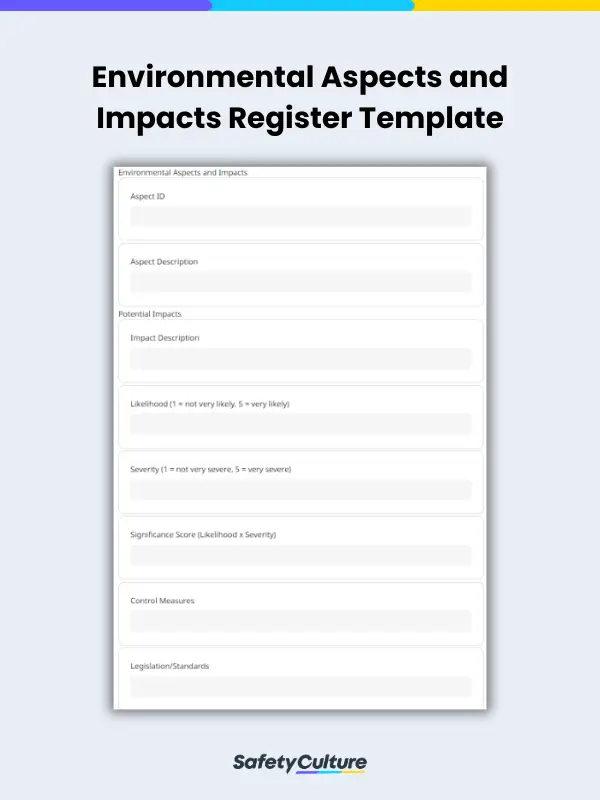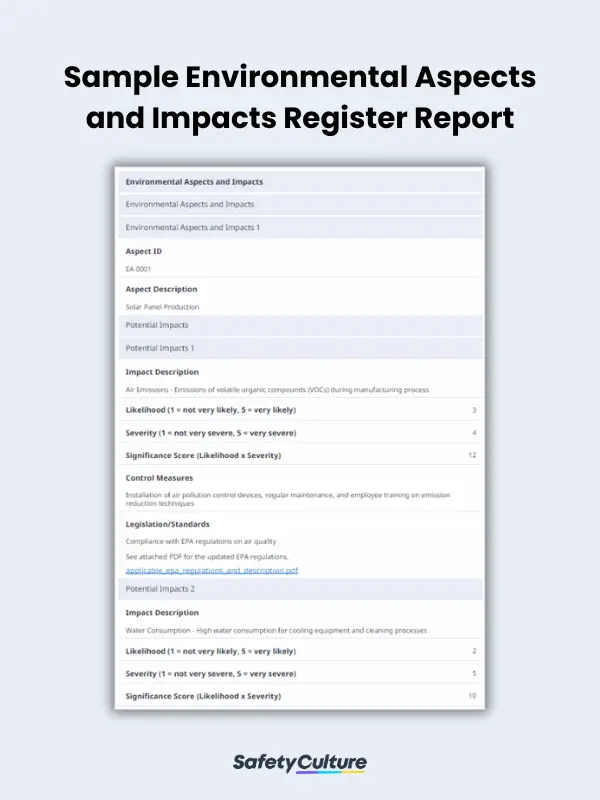What is an Environmental Aspects and Impacts Register?
An environmental aspects and impacts register is a document, database, or repository that organizations use to identify, record, assess, and manage the environmental impacts of their activities, products, and services. This tool helps them understand how various aspects of their operations interact with or influence the environment so that they can prioritize improvement actions and regulatory compliance.
By documenting environmental aspects and impacts using a register, organizations can set objectives, implement controls, and monitor performance to minimize negative environmental effects and enhance sustainability.
For context, an environmental aspect pertains to any element of an organization’s activities, products, or services that can affect the environment (e.g., energy consumption, waste generation, and use of natural resources). On the other hand, an environmental impact is the direct or indirect effect or consequence that an aspect has on the environment (e.g., human health and socio-economic conditions).
Role
The role of an environmental aspects and impacts register is multifaceted and pivotal in environmental management within organizations. Specifically, using a register template can help in the following:
Comprehensive Documentation and Analysis
It serves as a repository for documenting and analyzing the various environmental aspects and impacts associated with the overall business operations. By systematically identifying and assessing these aspects and impacts, the register enables organizations to prioritize actions and allocate resources effectively to mitigate or eliminate adverse effects.
Crucial Role in Regulatory Compliance
Using an environmental aspects and impacts register also helps organizations adhere to relevant laws and regulations. The tool allows them to maintain accurate and up-to-date records of their environmental performance, demonstrate their commitment to environmental stewardship, and ensure transparency to regulatory authorities.
Fundamental for Environmental Management Systems (EMS)
The International Organization for Standardization’s ISO 14001 is an internationally recognized standard for establishing, implementing, maintaining, and improving an organization’s environmental management practices.
To easily identify and evaluate key environmental aspects, which is an essential component of the ISO standard, using a register serves as a fundamental tool for fulfilling the standard’s requirements and maintaining conformance. Additionally, it also helps with regulating and organizing data from environmental monitoring sensors, further assisting in managing compliance and improving EMS in place.
What to Include in This Template
To help make the template easier to fill out, a basic environmental aspects and impacts register template must feature the following items and sections:
- Title Page
- Environmental Aspects Identification and Impacts Assessment
- Severity and Likelihood Assessment
- Significance Score
- Control Measures and Legislation/Standards
- Completion Page
How to Create and Use an Environmental Aspects and Impacts Register
Generally, you may follow these steps to effectively establish and implement a streamlined process of using this register template:
- Define the scope and boundaries of the register, outlining the activities, products, and services to be included.
- Identify relevant environmental aspects associated with the organization’s operations, considering inputs, outputs, and interactions with the environment.
- Evaluate the significance of each environmental aspect based on their severity and likelihood, assigning scores accordingly.
- Assess the potential environmental impacts associated with significant aspects, considering their magnitude and extent.
- Develop control measures and mitigation actions to minimize or eliminate adverse environmental impacts, specifying responsible parties and timelines.
- Review and update the register regularly to reflect changes in operations, regulations, and stakeholder expectations.
- Communicate the contents of the register to relevant stakeholders, ensuring transparency and accountability in environmental management practices.
Environmental Aspects and Impacts Register Example
Here’s a sample of a filled-out environmental aspects and impacts register template when exported as a report:
FAQs About Environmental Aspects and Impacts Registers
Typically, an organization’s environmental management team or safety personnel are the ones who maintain the environmental aspects and impacts register. However, it’s important to note that inter-department collaboration and senior management support are a must to ensure accurate data collection, analysis, and corrective actions.
Engaging with stakeholders such as employees, communities, regulatory agencies, and environmental organizations provides valuable insights into the potential consequences of activities and helps identify relevant criteria for scoring.
By incorporating diverse perspectives and input from stakeholders, organizations can enhance the accuracy and comprehensiveness of their risk assessments, leading to more informed decision-making and effective management of environmental impacts.
Organizations should review and update their environmental aspects and impacts registers yearly to reflect changes in operations, regulations, and stakeholder expectations. However, more frequent reviews (i.e., quarterly or biannually) are also advisable, depending on the involved environmental risks.




